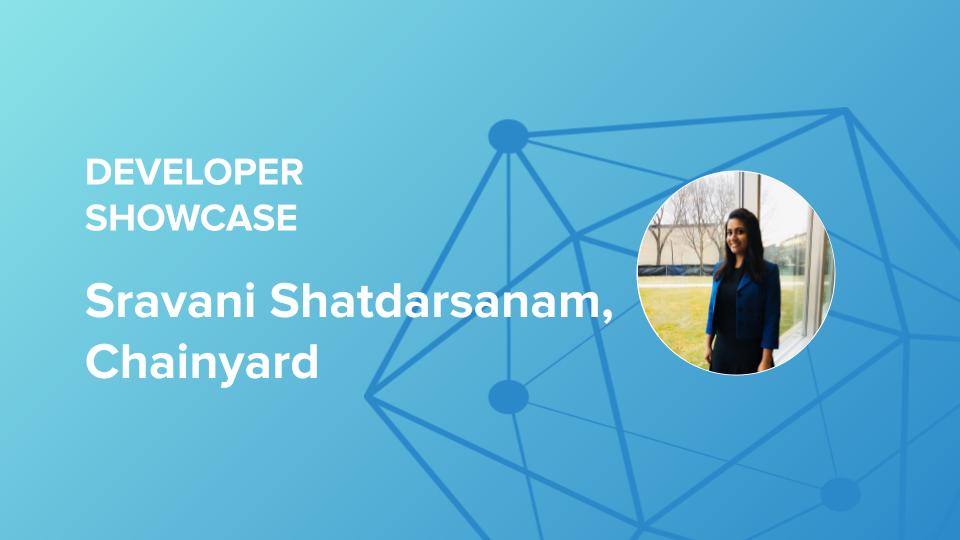
Back to our Developer Showcase Series to learn what developers in the real world are doing with Hyperledger technologies. Next up is Sravani Shatdarsanam, Software Engineer at Chainyard.
Give a bit of background on what you’re working on and how you got into blockchain
Supply chain involves many processes connecting raw material suppliers, procurement departments, quality departments, distributors, etc. The raw material supplies (e.g., a part) needs a certificate associated with it, which generally is paper based. These certificates are sometimes mismatched, which causes a huge loss to the company in finding and attaching the right certificate to the right part and may also violate the compliance requirements. I am working on a solution that helps in resolving this problem by creating a digital tamper proof certificate that can be verified cryptographically and ensure the reduction of certificate mismatches.
Three years ago, while pursuing my Master’s degree, I was introduced to blockchain, when one of the teams presented on “Securing IoT using Blockchain” at “The Forensure’18 – Cyber Security & Forensics Conference and Expo.” I became intrigued and started to attend bootcamps where I learnt about developing decentralized applications in Ethereum.
What Hyperledger frameworks or tools are you using in your projects? Any new developments to share? Can you sum up your experience with Hyperledger?
I have been majorly working on Hyperledger Fabric SDK Go. I started working with automation testing, penetration testing and bug fixes and eventually went on to working closely with the architecture team in setting up networks based on the requirements, writing smart contracts for specific types of transaction, and executing them on the networks.
What do you think is most important for Hyperledger to focus on in the next year?
Provide good training materials for certifications. Ideally, this would be a semester course for students to gain knowledge along with a certification. Hands-on labs, based on the level of experience, could also be provided.
What advice would you offer other technologists or developers interested in getting started working on blockchain?
Blockchain is a very interesting technology, but often people misinterpret it to be a cryptocurrency. Any new developers need to first understand the basic difference, and then the journey gets interesting and easier from there.
As Hyperledger’s projects continue to mature, what do you see as the most interesting technologies, apps, or use cases coming out as a result?
I find Trust Your Supplier really interesting. Built on blockchain, Trust your Supplier creates a trusted source of supplier information and digital identity that simplifies and accelerates supplier onboarding and lifecycle management.
Procurement organizations have permissioned access to pre-verified supplier information through a single application with aggregated supplier data and standardization across industries. Data Providers and other third parties enhance the ecosystem of services to provide an integrated experience allowing marketing analysis prior to onboarding tasks and continuous monitoring of suppliers.
What’s the one issue or problem you hope blockchain can solve?
Ledger Archiving and Pruning: Most of the projects involved with blockchain involve large transactional volumes of data. These large volumes can be difficult to maintain due to the payload size and need to record endorsers for that transaction, which can require added storage capacity. If researchers can come up with an approach to prune the ledger, archive the old data, manage the overall storage, and still retain trust in the ledger, this will help most of the customers dealing with huge volumes of data and lead to more adoption.
Where do you hope to see Hyperledger and/or blockchain in five years?
The best way to predict the future of this technology is to look at the way it has evolved. Trust is one of the key factors of blockchain as it eliminates the man in the middle process. Five years from now, this technology will be adopted by many organizations and used in many applications with users benefiting from the real-time aspects enabled by blockchain.
What is the best piece of developer advice you’ve ever received?
To become proficient in the work you do, get their basics right. Then you can achieve your goal.
What technology could you not live without?
The Internet
Sign up for Hyperledger Horizon & /dev/weekly newsletters
By signing up, you acknowledge that your information is subject to The Linux Foundation's Privacy Policy